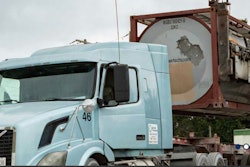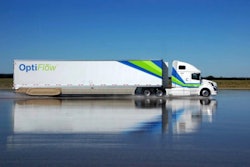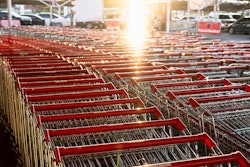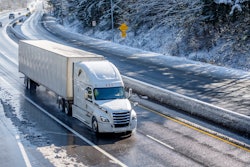We’ve seen major hurricanes run into late November and in 2021 Tropical Storm Wanda knocked out power throughout New England, and coastal Massachusetts saw hurricane-force wind gusts, causing damage to numerous homes and obstructing many roadways.
Joining Jason and Matt this week on CCJ's 10-44 is Michael Farlekas, CEO of connected supply chain SaaS platform e2open, who says the best thing a carrier can do is to become part of a shipper’s response plan and integrate itself as part of the strategy when any disaster strikes and the shipper has to pivot.
Contents of this episode
00:00 Becoming part of a shipper’s response plan
02:20 Transportation Management System overview
03:58 Automation and personal relationships
06:40 Shippers are embracing automated decision making
08:40 Networks of networks
Transcript
Jason Cannon
There's a lot more that goes into severe weather planning than just watching where Jim Cantore winds up, and if you do it right, you can take advantage of it.
Hey everybody, and welcome back to the 10-44 a weekly episode from the editors here at CCJ. I'm Jason Cannon and my co-host on the other side is Matt Cole. We're pretty deep into the back half of the Atlantic hurricane season, but that doesn't necessarily mean that the worst is behind us. We've seen major hurricanes run into late November, and just last year, tropical storm Wanda knocked out power throughout New England, and coastal Massachusetts saw hurricane force wind gusts that caused damage to numerous homes and obstructed many roadways.
Matt Cole
Even if a carrier manages to dodge a severe weather event in the physical sense, any impact on their customers is going to have some influence on the fleet one way or another. Michael Farkelas, CEO of supply chain management company e2open says the best thing a carrier could do is to become part of a shipper's response plan and integrate itself as part of the strategy when any disaster strikes and the shipper has to pivot.
Michael Farlekas
I think generally the easiest and best way to become more agile, which is what we're talking about, is to build the structure and infrastructure of your business that allows you to change things very quickly. And that would mean a very close alignment with my customers. That would mean a lot of integration with my customers. That would mean having the technology, interesting ways to make sure that you can react as quickly as possible. That's how you would be more agile in general, is to kind of build in the infrastructure ahead of time so you can decide literally, okay, we're going to execute this plan and you have everything in place to execute the plan.Now that would be what you would do prudently in kind of building your business. I mean, building resiliency and agility into supply chain is really what our customers are doing right now, and that doesn't show up in just a weather event. I mean, we saw that with tariffs. You saw that with Covid. We've seen that now with unfortunately the war. The world is becoming more uncertain and you can therefore no longer rely on static kind of pre-built ways of operating. You have to be able to operate from lots of different geographies all at once.
Jason Cannon
Now, this is where TMS can be your friend Michael says, by putting your fleet in front of tens, maybe hundreds, even thousands of potential customers that are all in search of some kind of relief.
Michael Farlekas
For instance, we have a TMS. We operate a carrier network. We have 10,000 carriers connected to it. But by having a connected network and having carriers connect to a network like ours means that as our customers, we have 200 or so TMS customers that operate on one system, about 60,000 loads a day get fixed. By having the carriers connected to them that means that as the shippers need to react, they have an automated way to be able to interact with the carriers regardless of where they are. So for the carriers. What that means is I can look at, create more options for myself to accomplish what I need to accomplish in any scenario.
And what that means for the trucking company, the carrier, is that because I can have access to a lot of shippers in one place, that gives me a lot more touchpoints of being able to take advantage of that opportunity. Meaning if a company's a national brand and they're making some kind of a product that's available nationally, that means they're all going to have the same issue at the same time. As a carrier having access to that large network would be extremely valuable. So that way as they react, they can be there front and center and be able to participate in that change.
For instance, maybe they weren't a customer because they didn't really have to ship things from A to B, but now they do for a temporary basis. That means they have an opportunity to become their customer.
Matt Cole
To get ahead of the next event, be it a hurricane, ice or anything, even a rail strike, Michael says, carriers need to get in front of as many customers as possible in a fast and automated way. And that means removing some of the personal relationships from the carrier selection process.
Michael Farlekas
You kind of see that happening, obviously with the digital freight brokers. That's kind of the role they're moving into, which is how do you automate what was a very manual process. For years it was, I'm a shipper and I have my four or five brokers that I do business with, and I call them up and I say, "Hey, listen, I need to move something from A to B on an emergency basis or spot basis. What can you help me with?" And then I as the broker go out and try to figure out either how to do it myself or how do I use my network to be able to access those lanes and those carriers.
I think where it's all heading is a much, much more automated process, where you're not going to have people involved in any of it. It'll just be all automated, really bringing together the shippers and the carriers. I think that is happening now and I think that would be how I would advise. If I was a trucking company and I was devising, that would be like you have to find a way to get to as many networks as possible because if you're relying on personal relationships, that is going to go away. That's just not going to be the way business is done. There's not enough time, not enough people. It has to be automated and it's happening kind of before our very eyes.
Jason Cannon
Michael says he's seeing more shippers embrace applications that automate decision making of what they should ship where and how. But before he tells us how carriers can benefit from that. Let's hear from 10-44 sponsor Chevron lubricants.
Protecting your diesel engine and its after treatment system has traditionally been a double edged sword. The same engine oil that is so essential to protecting your engine's internal parts is also responsible for 90% of the ash that is clogging up your DPF and upping your fuel and maintenance costs. Outdated industry thinking still sees a trade off between engine and emission system protection and Chevron was tired of it, so they spent a decade of R and D developing a no compromise formulation.
Chevron lubricants developed a new ultra low ash diesel engine oil that is specifically designed to combat DPF ash clogging Delo 600 ADF with Omnimax technology cuts sulfate ash by whopping 60%, which reduces the rate of DPF clogging and extends DPF service life by two and a half times. And just think what you can do with all the MPGs you're going to add from cutting your number of regions. The Delo 600 ADF isn't just about after treatment. It provides complete protection, extending drain intervals by preventing oil breakdown. Before you had to choose between protecting your engine or your after treatment system, and now you don't. 600ADF from Delo with Omnimax technology, it's time to kick some ash.
Michael Farlekas
Every day I want to process a number of shipment orders that I need to make and I want to make sure I have a transition plan that optimizes the mode and it optimizes the rate within the mode, which is suggest carriers. That's been happening and it continues to happening. What's happening now that's different is that since all that activity is moving much more aggressively into the cloud, you get a scenario where you have consolidation of markets. Meaning with us, for instance, if you connect as a carrier to our network, you get access to all the shipments that are being planned in a specific day.
I think that's the big growth area, and we've seen it ourselves in a very big way in the last really two or three years, where carriers are actively pursuing, participating in our network so that they can get access to more opportunities to ship loads for shippers. And they want to do that in an increasingly automated way. And the ones that are adopting that and have built on their side, the infrastructure to accept that and to automate their own process internally are the ones that are going to be successful.
Meaning if I'm a carrier, I can't just know that I somebody wants to have an OD pair priced. I have to be able to automatically price that and respond within sub seconds or within few seconds. So that means I need to get access to a network and I need more automation inside my own infrastructure so I can accurately present a price and delivery options and time to that shipper when they want it, when they need it. That's really the big growth area. And I think that it's both on access to networks as well as the carriers investing in technology to make sure they can give a price in a timeframe that's nearly instant.
And that's why these digital freight brokers are really kind of taking off. The ones that adopt quickly are the ones that are going to get a lion's share of that business. And the ones that adopt slowly are going to see their market share decline because they can't just rely on a phone call anymore. The phone call's going away.
Matt Cole
Networks of networks allow carriers to be more efficient and more strategic on how they want to balance their load selection.
Michael Farlekas
It's the concept of networks is becoming a reality. And what's enabling it is really cloud technology, is really allowing concentration. And that's a shift from it was even five or six years ago where every big shipper had their own deployment of a system on their premise. And that means that if I'm a carrier, I can't go to one place to get all the shipments. That's really the big story, is that these are becoming much more networked fundamentally, and that networking fundamentally of these processes is drives an extraordinarily high amount of value both for the shipper and for the carrier. The carrier becomes more efficient.
Now the other way to think about it, the next step of this is carriers can start thinking about strategically how they want to balance their head haul and their back haul so that they can capture as much of those economics as possible. In the past, it was always the shipper that captured much of the economics of the back haul. And I see the carriers, the ones that use technology effectively, can strategically and thoughtfully be able to price accordingly to take advantage of the back haul and capture as much of those economics as they possibly can. And that means a lot for the carriers in terms of their own profitability.
Jason Cannon
That's it for this week's 10-44. You can read more on ccjdigital.com. And as always, you can find the 10-44 each week on CCJ's YouTube channel. And if you've got questions, comments, criticisms or feedback, please hit us up at [email protected] or give us a call at 404-491- 1380. Until next week, everybody stay safe.













